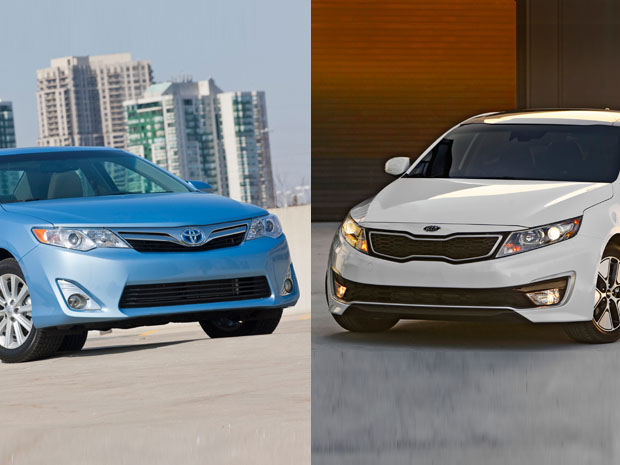Fuel Economy Comparo: Kia Optima Hybrid vs. Toyota Camry Hybrid
Story by John LeBlanc
Feel free to thank the rising price of fuel and stricter government-mandated fuel economy ratings for today’s variety of new gasoline-electric hybrid vehicles. Once limited to being quirky or small when they arrived in the late 1990s, hybrids now come in all shapes and sizes.
Overall, hybrids still make up a small portion of new vehicle sales, but some of the more popular models can be found in the ubiquitous family sedan class. All the mainstream automakers offer a hybrid variant, two of which are the Kia Optima Hybrid and Toyota Camry. So we asked: Which one is the better hybrid family car?

FIRST PLACE: 2013 Toyota Camry Hybrid XLE
Six years after the first Toyota Camry Hybrid arrived, a thoroughly refreshed version debuted for 2012, along with the rest of its gas-only siblings. Toyota’s head start in the hybrid business over Kia is evident in the 2013 Camry Hybrid XLE’s high level of refinement, performance — and most importantly — fuel economy.
Improvements to the Toyota’s hybrid powertrain start with its gas engine. The Camry Hybrid’s four-cylinder grew from 2.4 to 2.5 litres in displacement. Matched to a main electric motor (a second e-motor is used for the stop/start feature, among other duties), combined horsepower goes up to 200 from 187. The result is about a half-second drop in the Toyota’s zero-to-100-kilometres-an-hour run, now just less than eight seconds — or about one second quicker than the Kia Optima Hybrid.
Externally, the Camry and Optima are within millimetres of each other. Both offer similar amounts of room for their respective five passengers, but the Toyota offers more rear trunk space: 13.1 cubic feet, compared to the Kia’s 10.8. However, not only is that less room than their gas-only counterparts, neither the Camry nor Optima hybrids offer split-fold-down rear seats, settling for package passthroughs.

On top of the added straight-line performance, Toyota’s biggest improvement with its second-generation Camry Hybrid is its reason for being: excellent fuel economy. The Toyota sedan’s government fuel consumption estimates have improved to 4.5 litres per 100 kilometres in the city and 4.9 on the highway, compared to the last model’s 5.7 it scored both in and out of town. In real world driving, we scored 5.8 L/100 km.
Impressive fuel economy ratings aside, informed new car buyers know premium hybrid pricing pretty much negates any savings in fuel costs. In response, Toyota has slowly dropped the Camry Hybrid LE’s base price to $30,200 (all prices include freight and pre-delivery inspection fees) — about $5,000 less than an admittedly better-equipped 2011 Camry Hybrid.

SECOND PLACE: 2013 Kia Optima Hybrid
When it was introduced for 2011, the mid-sized, five-passenger, front-wheel-drive Kia Optima four-door sedan sent out a signal that the Korean automaker was now a serious contender to the more established Japanese brands. Stylish, feature-laden, well-made with excellent road manners, top-line gas-engine Optimas became real alternatives to low-end versions of the BMW 3 Series and Audi A4.
While our $31,450 Optima Hybrid costs more than a $30,855 Camry Hybrid XLE, the Kia is also better equipped, with items like satellite radio, a cooled glove box, a heated driver’s seat and automatic garage door opener as standard kit.
Hybrid or gas-only, the Optima interior is more upscale than the Camry, with more comfortable seats, and from behind it leather-wrapped steering wheel, driving enthusiasts will also prefer the Kia to the Toyota. The Optima Hybrid’s steering is quick, accurate and meaty, with a ride and handling package that nicely balanced. However, the hybrid part of the Kia sedan is less than satisfying.

Like its Hyundai Sonata platform-mate, the Optima Hybrid’s powertrain received some upgrades for 2013. A new electric motor adds seven more horsepower, but the 2.4-litre gas engine’s output drops from 166 to 159 hp, for a combined 199 rating. However, a higher-capacity lithium-polymer battery pack sees the Kia’s torque rating jump from 195 to 235 pound-feet. The end result is a reduction in fuel consumption estimates, from 5.8 L/100 km city and 5.1 highway to 5.4 and 4.9, respectively. Our Optima Hybrid returned 6.5 L/100 km in testing.
In actual use, we preferred the Kia’s more conventional six-speed automatic transmission to the Toyota’s continuously variable auto. But the interaction between the Kia’s hybrid bits — toggling between the electric and gas modes and the regenerative braking system — showed the automaker’s lack of hybrid powertrain experience. Starting off from a stop, there’s a slight hesitation from the Optima Hybrid’s engine department. And once underway, the engine would rev up a bit, then down a bit, without any indication of a change from the speedometer. Weird.
Stopping the Kia hybrid was also touchy. The regenerative braking system (which sends energy back to charge the batteries), would grab too much when the brakes were initially applied at lower spends. Once again, areas of refinement Toyota has already nailed down.
Skip the hybrid bits, and we’d take a gas-engine Optima over a gas-engine Camry. But as a hybrid, the Toyota wins.






![[del.icio.us]](https://www.straight-six.com/wp-content/plugins/bookmarkify/delicious.png)
![[Digg]](https://www.straight-six.com/wp-content/plugins/bookmarkify/digg.png)
![[Facebook]](https://www.straight-six.com/wp-content/plugins/bookmarkify/facebook.png)
![[Google]](https://www.straight-six.com/wp-content/plugins/bookmarkify/google.png)
![[Reddit]](https://www.straight-six.com/wp-content/plugins/bookmarkify/reddit.png)
![[StumbleUpon]](https://www.straight-six.com/wp-content/plugins/bookmarkify/stumbleupon.png)
![[Twitter]](https://www.straight-six.com/wp-content/plugins/bookmarkify/twitter.png)
![[Email]](https://www.straight-six.com/wp-content/plugins/bookmarkify/email.png)